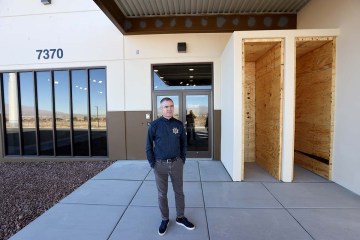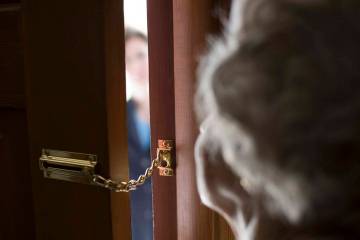Sun City Summerlin residents not getting the answers they want regarding coyotes
OK, folks, here are some hard facts about those coyotes that live in our midst, albeit facts you won’t like.
Yes, we have a severe coyote population problem throughout northwest Las Vegas. In fact, there are more coyotes roaming out and about in Summerlin than anyone would care to estimate. Even wildlife and animal control officials refuse to hazard a guess about how heavy the coyote population really is. They’ll only say that there are “a great many.”
No, there is no way to eradicate these predators that look to feed on your small and even medium-sized pet dogs and cats — especially if you leave them outside on their own, irrespective of whether your backyard is gated. And no, again, do not leave food outside, despite the fact that ancestors of coyotes derived from the same sector of the dog family that maybe your loveable pup came from.
That’s the way a trio of experts on the subject recently summed up the problem before an audience of approximately 200 concerned and often emotional residents of Sun City Summerlin, several of whom had lost pets to coyotes with healthy carnivorous appetites. Still, they expressed appall after hearing some of the cold, hard facts.
“Killing coyotes will not remove the threat. If you get rid of a large number of them now, there will only be an explosion of the predators next year, with just as many coyotes as there are at present, if not more,” said Josh Cerda, urban wildlife coordinator for the Nevada Department of Wildlife.
That was certainly not what many folks expected to hear, but it was a very forthright statement, as Cynthia Leavitt certified. “We cannot eradicate coyotes. We just have to learn to live with them,” said Leavitt, who is the animal control supervisor at the city of Las Vegas Department of Detention and Enforcement.
Still, while these wildlife outcasts will never become our best friends, unlike other members of the dog family, there are things we can do to discourage them from hanging around our property, said Karen Layne, president of the Las Vegas Valley Humane Society.
“Dusk is a favorite time of day for them. Food brings coyotes. Lots of people feed their animals at night. The fruit from trees in backyards attracts coyotes. Garbage bags attract them,” Layne said. Her reference was to residents who, despite sufficient evidence to the contrary, continually put their trash outside the night before for morning garbage pickup. The same plastic-filled bags of trash attract rabbits, feral cats, rats, mice and birds, all of which also are prime sources of food for coyotes.
But we have heard these warnings before. Coyote expert Jennifer Waithman from the Department of Wildlife, talking to a similar audience in Sun City more than two years ago, was quoted in this column on Aug. 21, 2014. Explaining how humans invaded an environment that belonged to coyotes for thousands of years, she said, “Don’t forget, coyotes were living here before we arrived. What’s more, what you like, they like.”
The hue and cry from many city slickers who moved to the desert of Summerlin resulted in another column on Feb. 5, 2015, in which I quoted Doug Nielsen, a spokesman for the Department of Wildlife. He said then: “There’s a very viable population of coyotes in Nevada, and for that reason they are an unprotected species … As for the Department of Wildlife, we don’t monitor them as we do other animals. And we have no regulations that prohibit the shooting of coyotes.
“In the Las Vegas Valley, there’s probably a coyote for every lot … It’s hard to get people to understand that they shouldn’t leave food outside for either their pets or small animals. If you feed rabbits and squirrels, you are also inviting coyotes.”
Yet folks continually express anger and frustration over seeing coyotes, and most recently, several asked, “What can we do to protect ourselves and our pets?”
Leavitt replied, “There’s no easy or quick fix. If they’re hungry, small animals are their prey.”
Cerda emphasized that coyotes will not attack humans unless threatened. He also noted that in accordance with nature’s wildlife food chain, coyotes are most fearful of mountain lions and bobcats, which also roam this area.
Herb Jaffe was an op-ed columnist and investigative reporter for most of his 39 years at the Star-Ledger of Newark, N.J. His most recent novel, “Double Play,” is now available. Contact him at hjaffe@cox.net.






















